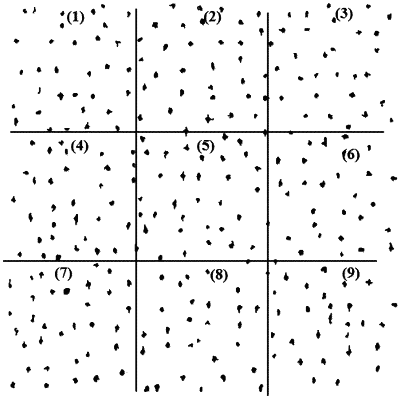| CPC G01N 1/286 (2013.01) [G01N 23/223 (2013.01); G01N 33/204 (2019.01); G01N 2001/2866 (2013.01); G01N 2001/2893 (2013.01)] | 8 Claims |

|
1. A method for statistical distribution characterization of dendritic structures in original position of single crystal superalloy, comprising the following steps:
step 1, processing a to-be-tested sample and determining a calibration coefficient;
grinding and polishing a (001) surface of directionally solidified single crystal superalloy containing characteristic elements to obtain the to-be-tested sample, wherein the content distribution of the characteristic elements in the dendritic structures and inter-dendritic structures is different;
conducting homogenization heat treatment on a directionally solidified single crystal superalloy block to obtain a calibration sample, wherein the calibration sample and the to-be-tested sample have the same composition and structure;
detecting the calibration sample by inductively coupled plasma atomic emitted spectroscopy to obtain the element content of the calibration sample from a chemical method;
grinding and polishing the surface of the calibration sample, conducting surface scanning on the calibration sample by a microbeam X-ray fluorescence spectrometry, and analyzing the scanning results to obtain the element content from a microbeam fluorescence method;
obtaining the calibration coefficient by dividing the element content from the chemical method by the element content from the microbeam fluorescence method;
step 2, obtaining a two-dimensional elemental content distribution map of the to-be-tested sample;
conducting surface scanning on the to-be-tested sample by the microbeam X-ray fluorescence spectrometry to obtain a fluorescence intensity data matrix, and converting the fluorescence intensity data matrix into an initial element content data matrix, wherein the conditions for the microbeam X-ray fluorescence spectrometry are the same as those in step 1;
obtaining a calibration element content data matrix according to the following formula:
C=C0*K
wherein C is the calibration element content data matrix, C0 is the initial element content data matrix, and K is the calibration coefficient; and the calibration matrix is graphically transformed to obtain the two-dimensional content distribution map of each element;
step 3, determining the number and average spacing of primary dendrites.
|